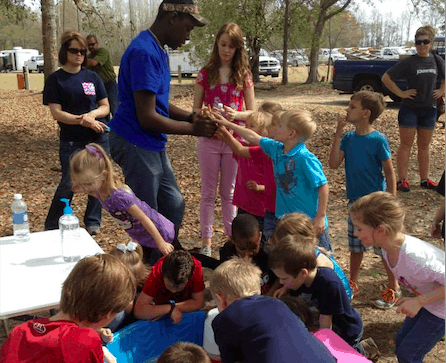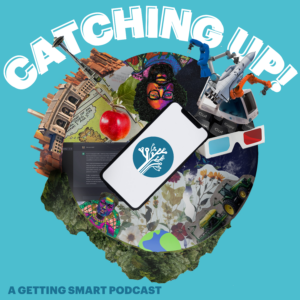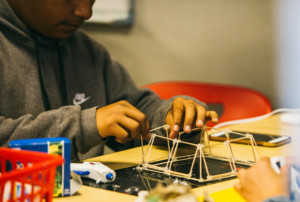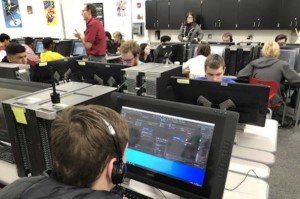Planning for Long Term Success through Sustainability and Scalability

This is the story of a public school district in Conway, South Carolina that refused to think that blended learning could only succeed in small charter schools. It is the story of an entire community that joined together to turn around their district by creating a blended, personalized experience for their students. It is the story of a district that is approaching financial sustainability in only 2 years. This is the story of Horry County School district (@HCSinfo).
For the Horry County School District (HCS) sustainability is key to each and every decision made. The district has found value in a pilot model at the middle school level that implements change quickly and provides a safe haven for building best practices to inform and transform work throughout the district and even the entire state. Whether it is technology, content, or staffing, the district is careful to keep an eye on scalability.
Technology
The district’s Personalized Digital Learning Initiative is designed to shift the district into a 1:1 model in a three-year phase (beginning January 2014). Students in grades 6 – 8 received devices in the first year, and the roll out continues with 9th -12th graders in the second year and 3rd – 5th graders in the third and final year. The initiative was funded in part through the local option sales tax for schools; however, the primary goal was to develop a plan that made the initiative sustainable within current resources. This initiative is supported within the existing funding with no additional cost to the taxpayers (technology is a capital investment, so the district was able to use funds from debt service to offset costs).
Currently In Phase 2 of the initiative, the district is offering a device take home option for its middle school and high school students. For a $50 fee, students can transport their devices back and forth between home and school AND will be covered for accidental damage.
Content
When it comes to content, the district is not only thinking about quality and engagement, but they are also looking at capability for long-term success by analyzing how the programs and tools fit into a sustainable budget. Grant funding from Next Generation Learning Challenges (@NextGenLC) was used at the Whittemore Park MS pilot site to select tools and strategies that supported the district’s identified goals to:
- Accelerate student achievement
- Increase student engagement
- Individualize learning
Funding supported trials of digital content, as well as a learning management system (Education Elements – @EdElements), a framework for enhancing school culture and developing a community of learners (Quaglia Institute for Student Aspirations – @QISAtweets), and tools for increasing college and career readiness (Education Policy Improvement Center – @EPIC_online).
Beth Havens, who works as a project assistant to support innovation at HCS, highlights how the blended program at Whittemore Park Middle School has been used as an example of productive shift in the district: “Whittemore Park Middle School teachers and students used a variety of digital and adaptive digital content, we examined growth and engagement of the students, and we used what we were learning in thinking about the best return on investment as well as what our district staff and teachers saw as the best alignment with standards and instructional goalsin content selections as we scaled to other middle schools in the district, realizing that we must choose carefully those products and tools which we could sustain within our current resources.”
Staffing
When working with digital tools, the reality is that change happens quickly and constantly. Strong professional development combined with ample practice time for teachers is an important element to successful implementation. HCS approaches professional development as ongoing job-embedded training that is designed to support and sustain teacher learning. As a district, they are always looking for unique ways to build a better professional learning community through the hosting and sharing of resources. This currently includes a range from Edmodo to iTunesU to newsletters and the district web site.
A partnership with Anthony Kim and Education Elements has helped to develop a train-the-trainer model. District learning specialists, including instructional technology and special education specialists, were trained in a variety of aspects of blended, personalized learning as well as in the technological tools. This included the devices and the learning management system, as well as delivery of training to both classroom teachers and to each school’s leadership team.
Learning Community
The district attributes much of their successful implementation to the collegial, learning community approach. In order to achieve true collaboration and community support, conversations, discussions, and decisions all involved representatives from multiple parts of the system (Board of Education members, learning services, IT, finance, assessment, facilities, teachers, students, parents, business leaders, community members, postsecondary partners, media, etc.). Havens explains, “Innovation and implementation of new learning models cannot be built in isolation if a district is to succeed in scaling, and honest discussions representing multiple viewpoints provide transparency, clarity, understanding, and consensus around the work.”
So…has it been easy? Havens truthfully admits, “It would be naively optimistic and absolutely untruthful to say Yes! This shift requires strategic thinking, goal setting, planning, and iteration; it requires collaboration and communication and creative problem solving and critical thinking; it requires us to be learners and to be leaders, even if at times these roles are new or uncomfortable; it is engaging, challenging, and renewing; it evokes a ‘can do ‘and ‘one for all and all for one’ (Three Musketeers) spirit. In fact, it is for us as the adults (and adult learners) in the system exactly the kind of learning experience and environment we want to create for our students.”
The story of HCS is more than one of financial sustainability; they are a story of dedication, persistence, and true turn around. The summer before Judy Beard became principal of Whittemore Park, she knew the school needed positive change and that the school was ripe for innovation that turned on the heels of solid finances. There was a lot to overcome in terms of perception due to situational and generational poverty — there was high free and reduced lunch numbers and a state report card grade of a D. That grade has since changed to a B and the school is now a model of blended learning and innovation for the district and the state, but they aren’t done just yet. With a model of continuous improvement at the heart of what the district does, they are constantly looking for ways to expand their reach and make education better for their students.
For more information on the HCS, check out Lessons from Horry County.
Next Generation Learning Challenges is a Getting Smart Advocacy Partner and Edmodo is a Learn Capital portfolio company where Tom Vander Ark is a partner.






0 Comments
Leave a Comment
Your email address will not be published. All fields are required.